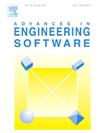Optimizing foam padding of the advanced combat helmet to maximize protection of blast-induced brain injury and wearing comfort
IF 5.7
2区 工程技术
Q2 COMPUTER SCIENCE, INTERDISCIPLINARY APPLICATIONS
引用次数: 0
Abstract
The Advanced combat helmet (ACH) is critical for mitigating the risk of blast-induced traumatic brain injury (bTBI). Helmet foam pads are in continuous contact with the head to provide mechanical support. They are essential for helmet bTBI mitigation effectiveness and wearing comfort. In this study, we parametrically investigate the significance of foam pad thickness and relative density on reducing the peak intracranial pressure (ICP) from blast. In addition, we study how they influence the perceived comfort, by quantifying the distribution uniformity of ACH-to-scalp pressure resulting from gravity, referred to as the Comfort Index. Three specific pad thicknesses and random relative densities coupled with a range of trinitrotoluene (TNT) masses placed to the front or side of the helmet-head complex were used for simulation. The incidence pressures from the ConWep model were used as input for blast loading. The ratios between peak ICP in the corpus callosum and the peak incident pressure as well as the comfort indices were analyzed using a data-driven approach. A multi-functional design method, Pareto front, was used to identify sets of optimal parameters based on user preferred weighting factors for ICP reduction and head surface pressure distribution. Finally, a decision tree was applied to refine the rules for optimal designs. For an equal weighting on ICP reduction and surface pressure distribution, a pad thickness of 10 mm and relative density of 7.7 % were identified. This study demonstrates the effectiveness of combining Pareto front and decision trees for the identification of optimal design parameters for the ACH.
优化先进战斗头盔的泡沫填充物,最大限度地保护爆炸引起的脑损伤和佩戴舒适性
先进战斗头盔(ACH)对于降低爆炸引起的创伤性脑损伤(bTBI)的风险至关重要。头盔泡沫垫与头部持续接触,提供机械支撑。它们对于头盔bTBI缓解效果和佩戴舒适性至关重要。在本研究中,我们参数化研究了泡沫垫厚度和相对密度对降低爆炸后颅内压峰值的意义。此外,我们通过量化由重力引起的ach -头皮压力分布均匀性(称为舒适度指数)来研究它们如何影响感知舒适度。模拟使用了三种特定的垫层厚度和随机相对密度,以及放置在头盔-头部复合物前部或侧面的三硝基甲苯(TNT)质量范围。来自ConWep模型的入射压力被用作爆炸加载的输入。采用数据驱动的方法分析了胼胝体ICP峰值与入射压力峰值之间的比值以及舒适度指数。基于用户偏好加权因子,采用多功能设计方法Pareto front来确定ICP降低和水头表面压力分布的最优参数集。最后,运用决策树方法对优化设计规则进行细化。对于同等权重的ICP减少和表面压力分布,垫厚度为10毫米,相对密度为7.7%。本研究证明了将Pareto front和决策树相结合用于ACH最优设计参数识别的有效性。
本文章由计算机程序翻译,如有差异,请以英文原文为准。
求助全文
约1分钟内获得全文
求助全文
来源期刊

Advances in Engineering Software
工程技术-计算机:跨学科应用
CiteScore
7.70
自引率
4.20%
发文量
169
审稿时长
37 days
期刊介绍:
The objective of this journal is to communicate recent and projected advances in computer-based engineering techniques. The fields covered include mechanical, aerospace, civil and environmental engineering, with an emphasis on research and development leading to practical problem-solving.
The scope of the journal includes:
• Innovative computational strategies and numerical algorithms for large-scale engineering problems
• Analysis and simulation techniques and systems
• Model and mesh generation
• Control of the accuracy, stability and efficiency of computational process
• Exploitation of new computing environments (eg distributed hetergeneous and collaborative computing)
• Advanced visualization techniques, virtual environments and prototyping
• Applications of AI, knowledge-based systems, computational intelligence, including fuzzy logic, neural networks and evolutionary computations
• Application of object-oriented technology to engineering problems
• Intelligent human computer interfaces
• Design automation, multidisciplinary design and optimization
• CAD, CAE and integrated process and product development systems
• Quality and reliability.
 求助内容:
求助内容: 应助结果提醒方式:
应助结果提醒方式:


